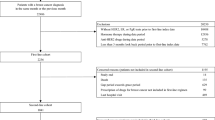Summary
Programs are presented for the calculation of received dose intensity in combination chemotherapy regimens. These provide methods for determining the final dose intensity, the mean cumulative dose intensity together with its standard error, and other tabular and graphic summaries. Two ways of dividing patients into high and low received-dose-intensity groups are proposed. Methods are illustrated using data from Mid-Atlantic Oncology Program (MAOP) 2183, a phase III evaluation of a six-drug alternating combination vs a three-drug “standard” combination treatment for extensive small-cell lung cancer. Comparisons of received dose intensity with demographic and outcome variables are presented.
Similar content being viewed by others
References
Anderson JR, Santarelli MT, Peterson B (1990) Dose intensity in the treatment of diffuse large-cell lymphoma. J Clin Oncol 8: 1927
Baar J, Tannock I (1989) Analyzing the same data in two ways: a demonstration model to illustrate the reporting and misreporting of clinical trials. J Clin Oncol 7: 969
Carter WH Jr, Wampler GL, Stablein DM (1983) Regression analysis of survival data in cancer chemotherapy, vol44. Marcel Dekker, New York, p 131
Cohen MH (1990) What determines actual chemotherapy dose intensity? J Clin Oncol 8: 1926
Coppin CML (1987) The description of chemotherapy delivery: options and pitfalls. Semin Oncol 14 [Suppl 4]: 34
Crawford SM, Newlands ES, Begent RHJ, Rustin GJS, Bagshawe KD (1989) The effect of intensity of administered treatment on the outcome of germ cell tumours treated with POMB/ACE chemotherapy. Br J Cancer 59: 243
DeVita VT Jr, Hubbard SM, Young RC, Longo DL (1988) The role of chemotherapy in diffuse aggressive lymphomas. Semin Hematol 25 [Suppl 2]: 2
Dodwell DJ, Gurney H, Thatcher N (1990) Dose intensity in cancer chemotherapy. Br J Cancer 61: 789
DuBois D, DuBois EF (1916) A formula to estimate the approximate surface area if height and weight be known. Arch Intern Med 17: 863
Fukuoka M, Furuse K, Saijo N, Nishiwaki Y, Ikegami H, Tamura T, Shimoyami M, Suemasu K (1991) Randomized trial of cyclophosphamide, doxorubicin, and vincristine versus cisplatin and etoposide versus alternation of these regimens in small-cell lung cancer. J Natl Cancer Inst 83: 855
Henderson IC, Hayes DF, Gelman R (1988) Dose-response in the treatment of breast cancer: a critical review. J Clin Oncol 6: 1501
Horning SJ, Kwak LW, Halpern J, Olshen RA (1990) Reply (to reference 1). J Clin Oncol 8: 1927
Hryniuk WM (1988) The importance of dose intensity in outcome of chemotherapy. In: DeVita VT Jr, Hellman S, Rosenberg SA (eds) Important advances in oncology. J.B. Lippincott, Philadelphia, p 121
Hryniuk W, Bush H (1984) The importance of dose intensity in chemotherapy of metastatic breast cancer. J Clin Oncol 2: 1281
Hryniuk WM, Goodyear M (1990) The calculation of received dose intensity. J Clin Oncol 8: 1935
Hryniuk WM, Figueredo A, Goodyear M (1987) Application of dose intensity to problems in chemotherapy of breast and colorectal cancer. Semin Oncol 14 [Suppl 4]: 3
Klasa RJ, Murray N, Coldman AJ (1991) Dose-intensity metaanalysis of chemotherapy regimens in small-cell carcinoma of the lung. J Clin Oncol 9: 499
Kwak LW, Halpern J, Olshen RA, Horning SJ (1990) Prognostic significance of actual dose intensity in diffuse large-cell lymphoma: results of a tree-structured survival analysis. J Clin Oncol 8: 963
Levin L, Hryniuk W (1987) The application of dose intensity to problems of ovarian and endometrial cancer. Semin Oncol 14 [Suppl 4]: 12
Miles DW, Earl HM, Souhami RL, Harper PG, Rudd R, Ash CM, James L, Trask CWL, Tobias JS, Spiro SG (1991) Intensive weekly chemotherapy for good-prognosis patients with small-cell lung cancer. J Clin Oncol 9: 280
Miller TP, Dahlberg S, Weick JK, Files JC, Eyre HJ, Pendergrass KB, Fisher RI (1990) Unfavorable histologies of non-Hodgkin's lymphoma treated with ProMACE-CytaBOM: a groupwide Southwest Oncology Group study. J Clin Oncol 8: 1951
Nichols CR, Tricot G, Williams SD, Besien K van, Loehrer PJ, Roth BJ, Akard L, Hoffman R, Goulet R, Wolff SN, Giannone L, Greer J, Einhorn LH, Jansen J (1989) Dose-intensive chemotherapy in refractory germ cell cancer — a phase I/II trial of high-dose carboplatin and etoposide with autologous bone marrow transplantation. J Clin Oncol 7: 932
Nichols CR, Williams SD, Loehrer PJ, Greco FA, Crawford ED, Weetlaufer J, Miller ME, Bartolucci A, Schacter L, Einhorn LH (1991) Randomized study of cisplatin dose intensity in poor-risk gern cell tumors: a Southeastern Cancer Study Group and Southwest Oncology Group protocol. J Clin Oncol 9: 1163
Roth BJ, Johnson DH, Greco FA, Einhorn LH, Goodlow JL, Cherng N, Randolph JA, Schacter LP (1989) A phase III trial of etoposide (E) and cisplatin (P) versus cyclophosphamide (C), doxorubicin (A), and vincristine (V) versus alternation of the two therapies for patients (PTS) with extensive small cell lung cancer (SCLC): preliminary results. Proc Am Soc Clin Oncol 8: 225
Skipper HE (1990) Dose intensity versus total dose of chemotherapy: an experimental basis. In: DeVita VT Jr, Hellman S, Rosenberg SA (eds) Important advances in oncology. J.B. Lippincott, Philadelphia, p 43
Tannock IF, Boyd NF, DeBoer G, Erlichman C, Fine S, Larocque G, Mayers C, Perrault D, Sutherland H (1988) A randomized trial of two dose levels of cyclophosphamide, methotrexate and fluorouracil chemotherapy for patients with metastatic breast cancer. J Clin Oncol 6: 1377
Wampler GL, Heim W, Ellison NM, Ahlgren JD Fryer JG (1991) Comparison of cyclophosphamide, doxorubicin, and vincristine with an alternating regimen of methotrexate, etoposide, and cisplatin/cyclophosphamide, doxorubicin, and vincristine in the treatment of extensive-disease small-cell lung carcinoma: a Mid-Atlantic Oncology Program study. J Clin Oncol 9: 1438
Author information
Authors and Affiliations
Additional information
For the Mid-Atlantic Oncology Program, 8811 Coleville Road, Suite 111, Silver Spring, MD 20901, USA
Rights and permissions
About this article
Cite this article
Wampler, G.L., Fryer, J.G. Calculation of received dose intensity for combinations of drugs using small-cell lung carcinoma treatment regimens as examples. Cancer Chemother. Pharmacol. 30, 199–206 (1992). https://doi.org/10.1007/BF00686312
Received:
Accepted:
Issue Date:
DOI: https://doi.org/10.1007/BF00686312




